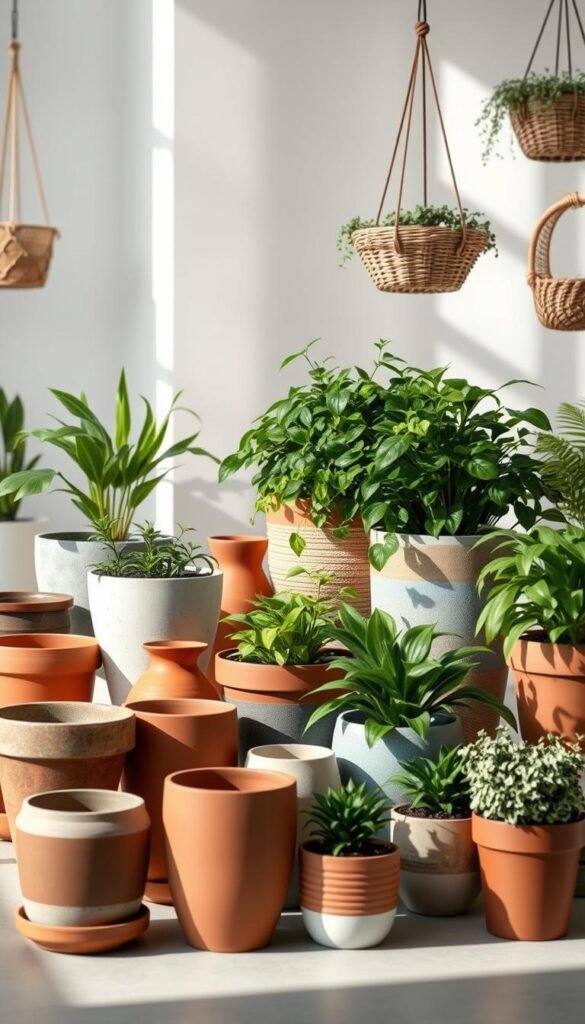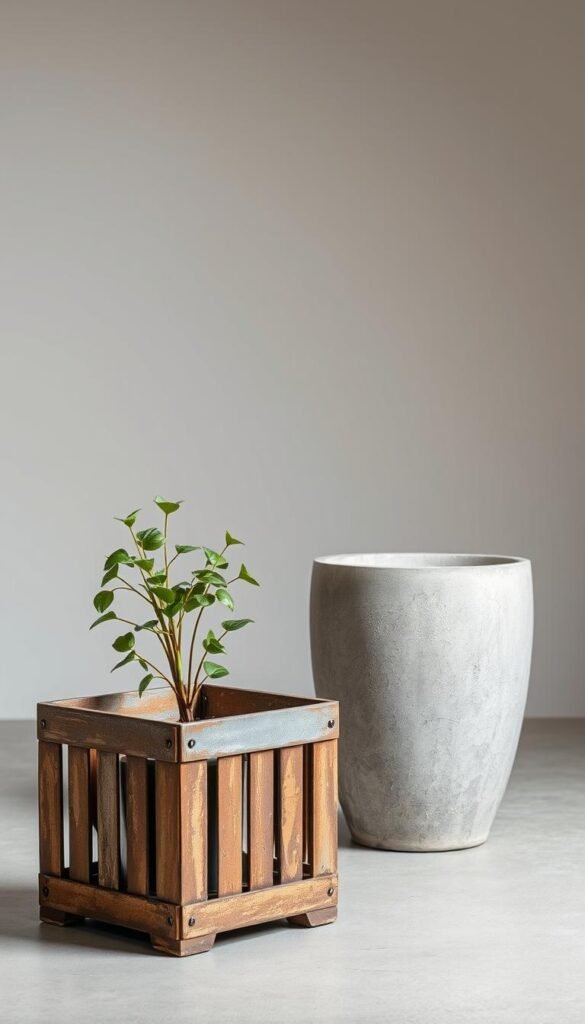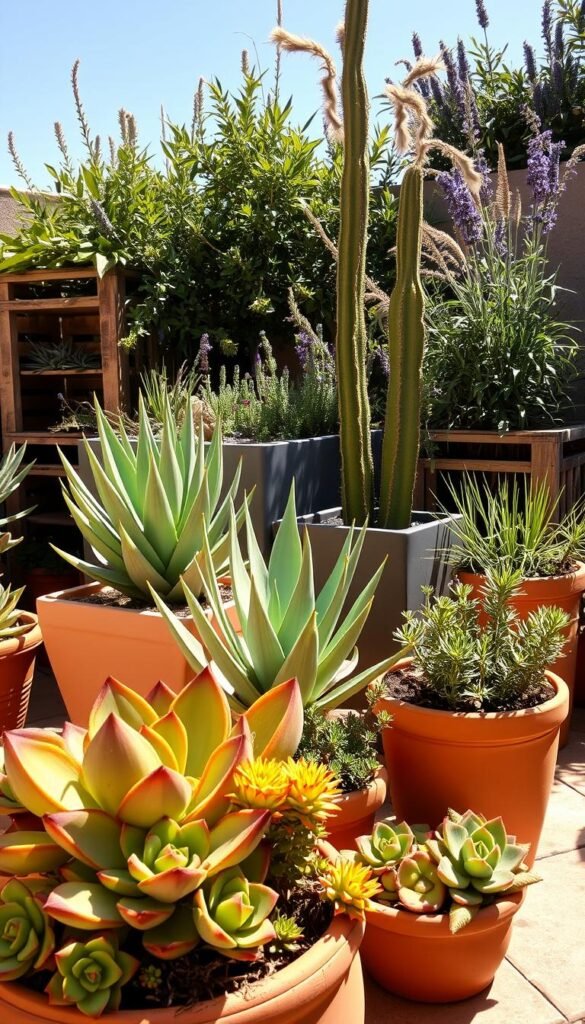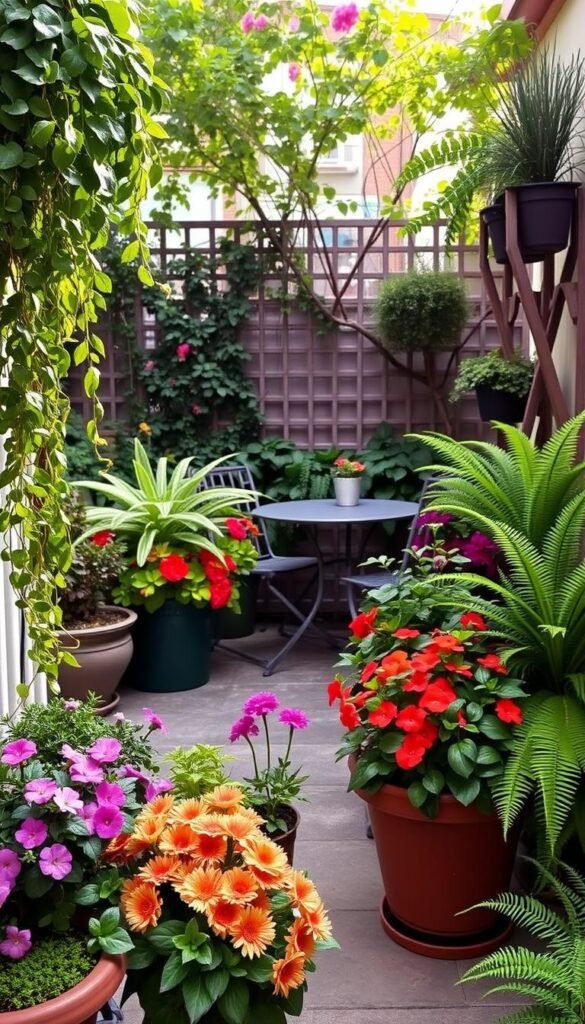Transforming tight balconies or cozy patios into lush retreats is easier than you think. By blending vibrant blooms and textured greenery in pots, you can craft a personalized oasis that thrives year-round. The secret? Smart design choices paired with the right growing techniques.
Start by selecting vessels that balance style and function. Lightweight fiberstone or ceramic options work well for renters, while self-watering planters simplify care. Pair trailing ivy with upright grasses in matching pots to create visual harmony without overcrowding.
New to gardening? Begin with low-maintenance succulents or seasonal annuals. Use quality potting mix enhanced with perlite for drainage – soggy roots spell trouble. Space containers to allow airflow between plants, preventing mold and pests.
Experts recommend grouping pots in odd numbers for dynamic arrangements. Try stacking vertical planters against walls to maximize floor space. Remember: shallow-rooted herbs thrive in window boxes, while deep planters support tomato vines.
Your outdoor haven should reflect your personality. Mix bold coleus leaves with delicate petunias, or create a monochromatic scheme using varying leaf textures. With thoughtful planning, even postage-stamp patios become inviting extensions of your home.
Transforming Your Patio into a Lush Garden Retreat
A thriving green oasis is within reach when you master container gardening. Start by choosing pots that serve both style and purpose. Bold hues or patterned ceramics instantly energize a space, while earthy tones create calm. Pair complementary shades like purple sage with yellow marigolds for eye-catching contrast.
Vary container heights and widths to build depth. Cluster tall planters at the back and trailing varieties up front. This layered approach makes small areas feel expansive. For year-round appeal, swap summer geraniums for autumn mums and winter evergreens.
| Container Size | Best Plants | Placement Tip |
|---|---|---|
| Small (6-10″) | Herbs, pansies | Edge of seating areas |
| Medium (12-18″) | Lantana, ferns | Along walkways |
| Large (20″+ ) | Citrus trees, hydrangeas | Focal points |
Native species like coneflowers or black-eyed Susans attract pollinators while needing less water. Leave breathing room between pots—about 6-8 inches—to prevent overcrowding. Add a bistro chair or bench to enjoy your handiwork. With smart planning, your retreat becomes a living masterpiece that evolves with the seasons.
Selecting the Perfect Container for Your Plants

The foundation of a thriving container garden starts with selecting the right vessel. Your pots need to support root development while complementing your outdoor aesthetic. Let’s explore how to balance practicality and personality in your choices.
Consider Size and Drainage for Healthy Roots
Oversized containers waste soil, while cramped ones stunt growth. Tomatoes need 5-gallon pots for robust roots, while herbs flourish in 8-inch depths. Always check mature plant sizes before choosing your vessel.
Drainage holes prevent soggy soil disasters. Add a gravel layer or perlite mix to boost airflow. Self-watering pots with reservoirs offer a safety net during heat waves.
Choosing Containers That Match Your Style
Concrete planters bring urban edge, while terracotta radiates rustic charm. Mix metallic finishes with woven baskets for eclectic flair. Remember: lighter materials like fiberglass simplify rearranging.
Vintage buckets or repurposed crates inject personality while housing trailing flowers. For cohesive design, repeat one material or color across multiple pots. Discover more practical container gardening tips to elevate your space.
Emphasizing Seasonal Color and Texture
Your outdoor area can shine in every season with smart plant rotations. Swap out specimens as temperatures shift to maintain year-round visual appeal. This approach keeps your setup fresh while working with nature’s rhythms.
Spring Blooms and Fall Foliage Inspirations
Start with tulips and daffodils in early spring, then transition to mums and ornamental kale come autumn. Pair pastel-colored pots with flowering bulbs for cheerful displays. When leaves change, introduce rust-toned vessels filled with fiery heuchera or Japanese maple saplings.
Decorative containers do double duty. Glazed ceramic protects roots during frosts, while lightweight resin makes seasonal rearrangements effortless. Cluster three staggered planters near seating areas to maximize your patio’s footprint.
Adapting Your Design Through Summer and Winter
Rotate sun-loving geraniums to south-facing spots during warmer months. In winter, shift evergreen boxwoods to sheltered corners. Use foldable side tables to create tiered arrangements when space feels limited.
Try these seasonal tweaks:
- Add trailing ivy to shade-sensitive summer annuals
- Wrap burlap around vulnerable pots during freezes
- Swap spent blooms for berry-filled branches in December
Group smaller containers around a statement piece—like a dwarf conifer—to anchor your layout. With each season’s shift, you’ll rediscover your patio’s potential.
Creative Plant Combinations and Pairings

Unlock your small outdoor area’s potential through clever plant partnerships. Pairing bold-leafed coleus with cascading sweet potato vine creates instant drama, offering shifting colors from spring frosts to summer heat. These dynamic duos thrive in tight quarters while delivering visual impact.
Spring’s arrival invites vibrant experiments. Cluster daffodils with feathery ferns for contrasting textures—the bulbs’ bright yellows pop against delicate greenery. As temperatures rise, replace spent blooms with drought-tolerant lavender and rosemary. Their silvery leaves release calming scents when brushed.
| Pairing | Key Features | Best For |
|---|---|---|
| Coleus + Sweet Potato Vine | Color contrast, trailing habit | Vertical planters |
| Lavender + Rosemary | Fragrance, low water needs | Edging walkways |
| Daffodils + Ferns | Seasonal interest, texture mix | Early spring displays |
Tall spiky plants like cordyline anchor arrangements when paired with creeping thyme. This “thrillers and spillers” approach maximizes limited ground space. Use just three varieties per container to avoid clutter—a single showstopper, one filler, and a trailer.
Rotate combinations yearly to keep your gardening experience fresh. Try purple basil with orange marigolds for edible flair, or mix ornamental grasses with pansies. These clever pairings prove even modest spaces can showcase nature’s artistry in exciting ways.
Design Ideas Inspired by Color and Texture
Turn your outdoor area into a living canvas through strategic plant partnerships. Contrasting hues and varied leaf shapes breathe energy into limited spaces, proving even modest setups can dazzle. Start by choosing plants that play well together while offering visual surprises.
Bold Pairings with Sweet Potato Vine and Coleus
Sweet potato vine’s cascading tendrils make perfect partners for coleus’s painterly leaves. The lime-green trailing variety softens coleus’s burgundy spikes, creating depth in vertical planters. This duo thrives through summer heat, requiring minimal care beyond weekly watering.
Try pairing ‘Blackie’ sweet potato vine with ‘Kong Rose’ coleus. Their purple-black and pink-veined leaves form striking contrasts. Add silver dichondra for metallic shimmer that catches afternoon light.
Mixing Patterns to Create Visual Interest
Striped caladium leaves dancing beside polka-dotted begonias add playful energy. Keep balance by repeating one color across different textures—like pairing ruby snapdragons with crimson heuchera. Odd-numbered groupings (3 or 5 plants) prevent visual chaos.
For cohesive gardens, follow these guidelines:
- Use one bold pattern as the focal point
- Combine matte and glossy leaves in similar tones
- Edge containers with neutral-toned sedum to ground bright colors
Discover more ways to enhance your space through vibrant container arrangements. With thoughtful pairings, your planters become evolving art installations that shift with the seasons.
Compact Patio Designs with Container Flowers and Foliage

Revitalize your outdoor nook by reimagining how plants and pots interact. The right mix of texture and scale transforms cramped areas into curated escapes. Discover fresh ideas that blend practicality with visual charm, making every square foot count.
Textured planters add depth to your setup. Try pairing rough concrete pots with velvety lamb’s ear leaves. Glossy ceramic vessels pop against feathery ferns. This contrast creates a polished look while highlighting nature’s diversity.
Three winning strategies for cohesive layouts:
- Repeat one container color across different sizes
- Use foliage plants as living backdrops for bright blooms
- Angle pots toward seating areas to maximize visibility
Space-saving ideas shine in vertical arrangements. Wall-mounted planters bursting with trailing ivy draw eyes upward, freeing floor space. Pair these with compact hydrangeas in tiered stands for layered beauty. Vertical gardening techniques prove especially useful in narrow areas.
Don’t fear bold experiments. Chartreuse heuchera makes orange marigolds glow brighter. Crinkled kale leaves complement smooth stonecrop succulents. Your space becomes a living mood board where texture tells the story. Rotate seasonal stars to maintain year-round intrigue.
The secret? Let your containers and plants converse. A weathered trough overflowing with lavender whispers rustic charm, while geometric planters housing ornamental grasses shout modern edge. Through thoughtful pairings, you’ll craft a look that’s uniquely yours – no sprawling yard required.
Incorporating Foliage and Ornamental Grasses
Elevate your outdoor space by blending structural grasses with lush foliage for dynamic visual impact. These natural elements add movement and depth while softening hard edges of urban environments. The secret lies in balancing vertical interest with thoughtful layering.
Adding Height and Layered Textures
Ornamental grasses like purple fountain or blue fescue create instant vertical drama. Pair their wispy plumes with broad-leafed hostas or coleus for contrast. Use tall, narrow planters to lift feathery varieties to eye level, making small areas feel grander.
Proper soil mix is crucial. Combine equal parts potting soil, compost, and perlite for drainage. This blend supports deep root growth in grasses while keeping moisture consistent for companion plants.
| Grass Type | Companion Plant | Design Tip |
|---|---|---|
| Japanese Forest Grass | Coral Bells | Edge walkways |
| Maiden Grass | Black-Eyed Susan | Backdrop focal point |
| Sedge | Ferns | Under-tree arrangements |
Creating Depth with Complementary Greens
Layer chartreuse hakone grass behind blue spruce sedum for cool-toned harmony. Add variegated ivy as spillers to connect different heights. This approach turns flat spaces into multidimensional displays.
Accentuate key points by clustering three grasses around a statement planter. For cohesion, repeat one foliage color across multiple containers. Rotate positions seasonally to maintain fresh sightlines.
Remember: grasses thrive in slightly acidic soil. Test pH annually and amend with peat moss if needed. Their low-maintenance nature makes them perfect for busy gardeners seeking year-round structure.
Innovative Use of Unconventional Containers

Who says planters need to be store-bought? Your outdoor space gains instant personality when you repurpose forgotten items into living art. An old toolbox becomes a rustic herb garden, while a retro colander drips with trailing sweet potato vine. These unexpected vessels spark conversations while reducing waste.
Texture plays a starring role in these creative pairings. Rough galvanized metal contrasts beautifully with velvety lamb’s ear leaves. A chipped teacup collection finds new purpose housing delicate succulents, their smooth surfaces highlighting spiky forms.
| Unconventional Planter | Texture Pairing | Plant Match |
|---|---|---|
| Galvanized Wash Tub | Industrial + Soft | Rosemary + Sweet Potato Vine |
| Vintage Colander | Perforated + Feathery | Ferns + Creeping Thyme |
| Repurposed Toolbox | Metallic + Glossy | Sedum + Purple Basil |
One gardener transformed a rusty bicycle basket into a mobile collection of pansies and ivy. The worn patina adds character, while the wire frame ensures proper drainage. Another used stacked paint cans to create a vertical tower bursting with sweet potato vine and petunias.
These projects prove sustainability meets style. That cracked birdbath? Fill it with drought-tolerant sedums. Chipped dinnerware becomes a whimsical fairy garden. By embracing imperfections, you craft spaces that feel authentically yours.
When curating your collection, balance bold textures with simpler plants. Let a weathered wagon wheel planter shine by pairing it with muted mosses. Your creative choices turn everyday objects into focal points that evolve with each season’s growth.
Smart Layouts and Seating Solutions for Small Patios
Maximizing every inch becomes an art form when working with limited outdoor areas. Smart arrangements blend lush container gardens with cozy seating to create spaces that feel both functional and inviting. The key lies in balancing greenery with room to relax.
Start by mapping traffic flow before placing any pots. Position taller planters near walls or railings to define boundaries without blocking movement. Pair compact benches with narrow side tables that double as plant stands. This approach maintains clear pathways while showcasing your greenery.
Movable furniture unlocks flexibility. Try lightweight stools that tuck under tables when not in use. Surround them with rolling planters on casters – you can easily rearrange your setup for gatherings or solo relaxation. Built-in seating with hidden storage underneath works wonders for stashing gardening tools.
| Layout Strategy | Seating Type | Benefits |
|---|---|---|
| Corner Clustering | L-shaped bench | Creates intimate nook |
| Central Focus | Bistro set | Encourages conversation |
| Perimeter Lines | Foldable chairs | Maximizes open space |
Multi-level displays add depth without crowding. Place cascading herbs in wall-mounted planters above a loveseat, or stack shallow pots beside a hanging swing. These vertical touches draw eyes upward, making ceilings feel higher.
Your container garden should complement seating areas, not compete with them. Frame a bench with matching pots of ornamental grasses, or use aromatic lavender near loungers to enhance relaxation. With thoughtful placement, every element works together to create your perfect outdoor retreat.
Effective Watering and Maintenance Strategies for Container Gardens

Keep your potted plants thriving with smart hydration hacks and simple care routines. Sweet potato vines demand consistent moisture, while creeping jenny prefers slightly drier soil between waterings. Test soil by pushing a finger knuckle-deep – if dry, it’s time to hydrate.
Morning watering reduces evaporation and prevents leaf scorch. For bushy potato vine growth, use diluted liquid fertilizer every three weeks. Always choose planters with drainage holes, adding pebbles at the base to prevent clogging.
Low-maintenance stars like creeping jenny simplify care. These vigorous spreaders tolerate occasional neglect, bouncing back quickly after dry spells. Pair them with drought-resistant sweet potato varieties for worry-free combos.
Adjust your schedule as seasons change. Summer may require daily watering, while autumn needs taper off. Track rainfall with a simple app or journal to avoid overwatering.
New gardeners thrive with these pro tips:
- Group plants with similar thirst levels
- Use self-watering pots for vacation periods
- Mulch soil surfaces to retain moisture
Watch for telltale signs – yellow leaves often signal overwatering, while crispy edges beg for hydration. With these strategies, your green companions will flourish through every season.
Adding a Touch of Drama with Plant Theaters and Hanging Baskets
Elevate your outdoor experience by thinking beyond ground-level arrangements. Plant theaters—multi-tiered displays that showcase greenery like performers on a stage—turn ordinary areas into living art installations. These vertical showcases work wonders in small spaces, drawing eyes upward while keeping floors clear for movement.
Hanging baskets become your secret weapon for aerial impact. Suspended from pergolas or shepherd’s hooks, they add depth without consuming precious square footage. Mix trailing ivy with spiky dracaena in woven planters for textural contrast that sways gently in the breeze.
Utilizing Vertical Elements for Dynamic Displays
Layer plants like a pro by varying heights and hues. Start with tall ferns in backlit corners, then place mid-height begonias in bright pots at eye level. Finish with cascading lobelia in hanging containers to complete the visual journey.
Vibrant colors amplify the drama. Try these combinations:
- Sunset-orange lantana in burnt sienna planters
- Electric-blue lobelia against white-washed baskets
- Variegated pothos spilling from glossy black hanging pots
Create focal points by clustering three matching baskets at staggered heights. This technique works beautifully above seating areas or flanking entryways. For quick changes, use removable liner inserts to swap seasonal blooms without disturbing permanent fixtures.
| Vertical Element | Plant Pairing | Color Strategy |
|---|---|---|
| Wall-mounted Shelves | Succulents + Air Plants | Monochromatic greens |
| Hanging Terrariums | Ferns + Moss | Emerald accents |
| Ladder Planter | Herbs + Petunias | Rainbow spectrum |
Don’t shy away from unexpected structures. Repurpose an old shutter as a backdrop for mounted pots, or train jasmine vines along a folding room divider. Your vertical garden becomes both conversation starter and space-saving marvel.
Curated Ideas for Drought-Tolerant and Low-Maintenance Plants

Create a water-wise oasis that thrives with minimal effort by choosing resilient plants. Drought-tolerant varieties like lavender and sedum deliver vibrant flower displays while surviving dry spells. These hardy stars reduce watering needs by up to 60% compared to traditional garden plants.
Low-maintenance options shine in fall when other blooms fade. Russian sage bursts with purple spikes through October, while ‘Autumn Joy’ sedum offers rosy clusters. Pair them with breathable terra-cotta planters that prevent root rot in sporadic rains.
| Plant | Key Feature | Ideal Planter |
|---|---|---|
| Lantana | Butterfly magnet | Concrete trough |
| Yucca | Architectural form | Glazed ceramic |
| Blanket Flower | Long bloom period | Metal raised bed |
Southwestern natives like agave thrive in shallow containers with gritty soil. Their sculptural shapes create striking contrasts against smooth planter surfaces. For quick color, add drought-resistant annuals like portulaca – their succulent leaves store moisture for weeks.
Three smart strategies for success:
- Group plants with similar water needs
- Use mulch to retain soil moisture
- Choose self-watering systems for vacation periods
These tough beauties prove you don’t need constant care for showstopping flower displays. As temperatures drop in fall, their textures and hues keep your space inviting. Pair sculptural aloe vera with flowing ornamental grasses in modern planters for a dynamic, fuss-free look.
Elevating Your Space with Statement Planters
Your outdoor area becomes a year-round showcase when anchored by bold planters. These eye-catching vessels do more than hold greenery—they sculpt your space’s personality. During winter’s muted months, a striking planter filled with evergreen branches or red-twig dogwood becomes a living sculpture.
Choose designs that mirror your aesthetic while enhancing seasonal charm. Sleek corten steel cubes glow against snowdrifts, while weathered whiskey barrels brimming with pinecones whisper rustic warmth. For urban edge, try geometric concrete troughs planted with ornamental kale.
Three ways to maximize impact:
- Flank entryways with matching oversized planters
- Use elevated stands to showcase intricate details
- Paint one bold hue on neutral walls to complement your planter
Strategic planting amplifies your vision. Nestle frost-resistant pansies around dwarf conifers in shallow bowls. In deeper vessels, layer bulbs beneath winterberry shrubs for spring surprises. This layered approach maintains interest even when temperatures drop.
| Style | Winter Plant Pairing | Placement Tip |
|---|---|---|
| Modern | Black Mondo Grass + Birch Branches | Near seating areas |
| Rustic | Holly + Cedar Sprigs | Along pathways |
| Eclectic | Succulents + Spray-Painted Branches | Focal points |
Invest in one showstopping planter as your space’s anchor. Rotate seasonal accents around it—poinsettias in December, witch hazel in February. Your curated display becomes an evolving work of art that defies winter’s chill.
Maximizing Space with Vertical Gardens and Green Walls

Reach new heights in your outdoor space by embracing vertical gardening solutions. These living walls transform blank surfaces into cascading displays of natural beauty, adding depth to tight areas. Vertical systems turn unused walls into thriving ecosystems, letting you grow upwards instead of outwards.
Start with modular panels or pocket planters for easy installation. Choose drought-tolerant grasses like blue fescue for texture, pairing them with trailing ivy. This combo creates movement while conserving floor space. Wall-mounted systems need only 4-6 inches of soil depth for most plants.
| Plant Type | Key Benefit | Vertical System |
|---|---|---|
| Ornamental Grasses | Year-round structure | Pocket planters |
| Ferns | Softens hard surfaces | Wall-mounted trays |
| Succulents | Low water needs | Vertical frames |
Mix feathery maidenhair fern with spiky yucca for striking contrast. The interplay of shapes enhances visual interest while maximizing your wall’s potential. Watering becomes efficient with drip irrigation kits designed for vertical setups.
For quick results, try pre-planted panels available at garden centers. Maintain your green wall by trimming overgrown vines and rotating plants seasonally. Add solar-powered LED strips to highlight textures at night, doubling your space’s functionality.
These installations do more than save space—they create serene retreats. The rustle of grasses in breeze adds calming white noise. Transform that bare wall into a breathing work of art that evolves with each growing season.
Bringing Together Color, Fragrance, and Functionality in Container Designs
Crafting an inviting outdoor space means balancing beauty and purpose through smart plant choices. Blend vivid blooms with aromatic herbs to create a multi-sensory experience that evolves through every season. This approach turns your home’s exterior into a living retreat that delights both eyes and nose.
Start by pairing colorful annuals with fragrant perennials for year-round appeal. Bright petunias thrive alongside rosemary’s silvery leaves, offering visual pop and kitchen-ready herbs. Edible flowers like nasturtiums add peppery zest to salads while attracting pollinators.
Smart designs adapt as temperatures shift. Swap spring pansies for summer marigolds, then transition to chrysanthemums in fall. Evergreen shrubs anchor arrangements during winter dormancy. This mix ensures continuous vibrancy without constant replanting.
| Season | Color Star | Fragrance Option | Functional Benefit |
|---|---|---|---|
| Spring | Pansies | Lilac | Early pollinators |
| Summer | Marigolds | Lemon Balm | Pest deterrent |
| Fall | Mums | Sage | Culinary use |
Multi-purpose containers shine in small areas. A tall planter with lavender serves as both privacy screen and stress-relieving aroma source. Window boxes bursting with thyme and violas soften railings while offering fresh garnishes.
Your home gains character through thoughtful mixes. Try purple basil with orange calendula for bold contrast and pesto ingredients. Add night-blooming jasmine near seating areas for evening fragrance. These combinations prove practicality and charm coexist effortlessly.
As seasons change, rotate plants to maintain visual flow. Tuck scented geraniums behind fall cabbages, then replace them with winter-blooming heather. Your space remains welcoming through nature’s cycles, becoming a true extension of your living area.
Final Reflections on Your Compact Patio Transformation
Ready to see your outdoor space flourish? Successful small-scale gardening thrives on three pillars: thoughtful preparation, artistic vision, and attentive care. By blending vertical elements with strategic plant choices, you’ve learned how to maximize every inch while creating depth through layered heights.
Remember that elevation transforms ordinary setups into eye-catching displays. Stacked planters or hanging baskets add dimension without cluttering floors. Pair tall grasses with trailing vines to guide the eye upward, making areas feel more expansive than their square footage suggests.
Your journey doesn’t end here. Rotate seasonal stars and refresh arrangements as your skills grow. Those mismatched pots? They’re opportunities for eclectic charm. That blank wall? A canvas for living art. With each choice—from soil blends to color schemes—you craft a space that mirrors your unique style.
Now’s the time to experiment. Play with contrasting textures in elevated planters or cluster varied heights along railings. Every adjustment brings new discoveries. Trust your instincts, celebrate small victories, and watch your green haven evolve into something truly extraordinary.






